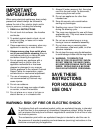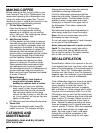
3
TABLE OF CONTENTS
Important Safeguards . . . . . . . . . . . . . Page 1
Unpacking Instructions. . . . . . . . . . . . . Page 2
Introduction . . . . . . . . . . . . . . . . . . . . . Page 3
The Quest for the
Perfect Cup of Coffee . . . . . . . . . . . . . Page 3
Features and Benefits . . . . . . . . . . . . . Page 4
Making Coffee. . . . . . . . . . . . . . . . . . . Page 5
Cleaning and Maintenance . . . . . . . . . Page 5
Decalcification. . . . . . . . . . . . . . . . . . . Page 5
Warranty . . . . . . . . . . . . . . . . . . . . . . . Page 6
INTRODUCTION
Congratulations on your purchase of the
Two to Go
®
Coffeemaker from Cuisinart.
Now you can brew your coffee ‘to go’. Brew
your favorite coffee into one or two of your
new stainless steel mugs and you’re ready to
leave the house. Your new coffeemaker has
single and double cup brewing positions, a
one touch ‘On’ switch, and automatically shuts
itself off after brewing is complete. It’s easy to
clean and easy to use.
THE QUEST FOR
THE PERFECT CUP
OF COFFEE
It is generally agreed that there are four basic
elements critical to the perfect cup:
Element 1: Water
Coffee is 98% water. Often overlooked, the
quality of the water is as important as the
quality of the coffee. If you filter your drinking
water, filter the water for your coffeemaker.
A good rule of thumb is that if your water
doesn’t taste good from the tap, it won’t taste
any better in your coffee.
For hard water areas, we recommend using
bottled water. The calcium in the water and
the softeners used to combat it have a major
impact on the extraction of coffee. Hard water
will also accelerate calcium buildup inside
the coffeemaker. Calcium buildup slows
down brewing, affects the flavor of the
coffee, and ultimately may shorten the life
of your coffeemaker.
Element 2: Coffee
While the bulk of the liquid is water, all of the
flavor should be in the coffee. Don’t expect to
achieve the same quality cup of coffee you’re
accustomed to drinking at a coffee bar, if you
don’t use the same quality beans or grounds.
If you choose to grind your own beans before
brewing, be sure to buy them fresh, ideally no
more than a two week supply at a time, and
buy them whole. Once the bean is broken,
its flavor degrades very quickly, so coffee
should be ground just prior to brewing.
If it is not practical to buy small supplies, we
recommend you separate larger amounts
of beans into one to two week portions
immediately after purchase and freeze them in
airtight containers. The best way to maximize
freshness is to minimize exposure to air, light
and moisture. So, once removed from the
freezer, the beans should be maintained in a
sealed container at room temperature, since
damaging condensation occurs every time
the beans are removed from the freezer or
refrigerator. Note that while some coffee
experts advise against freezing dark-roast
beans because it can cause the oils to coagu-
late, others disagree. We suggest you experi-
ment and decide for yourself.
Element 3: Grind
The grind is critical in proper flavor extraction.
If the grind is too fine, overextraction and
bitterness will result. Too fine a grind may
also clog your filter. If the grounds are too
coarse, the water will pass through too quickly
and the desired flavors will not be extracted.
We recommend a medium-fine grind.
Element 4: Proportion
Your stainless steel mugs hold 14 ounces
of coffee. Add the desired amount of
ground coffee corresponding to the number
of cups you are making – one or two
mugs. Many coffee bars and the Specialty
Coffee Association of America recommend
adding 2 rounded tablespoons of coffee
per 6 ounces of water. Some coffee
manufacturers recommend using one
tablespoon per 6 ounces of water. We
recommend 3 to 4 tablespoons of ground
coffee per mug, but use more or less to suit
your taste.










